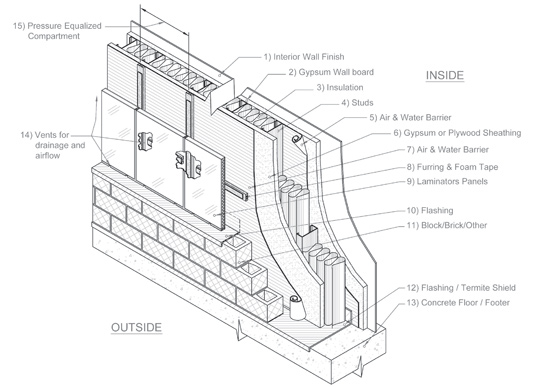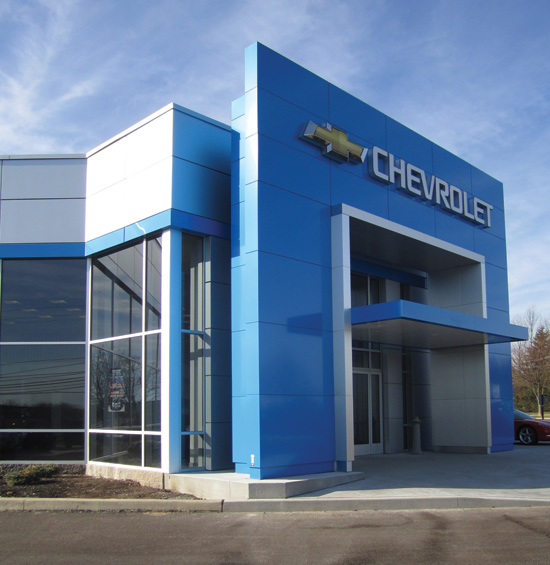Barrier vs. Rainscreen Exteriors
This can be solved by venting the exterior cladding, and making the weather barrier airtight. This way, most of the wind pressures are born at the surface of the inner leaf, which now serves as the air barrier. The pressure gradient across the cladding will be reduced, reducing the possibility for water getting pulled in by air pressure. The airflow from the bottom vent to the top vent will also have a drying effect that further reduces the chances for a wet wall.
This type of exterior works very well on a small building, and in residential applications, it is considered state-of the-art. But on a tall commercial building, there can still be problems created by pressure conditions in the airspace behind the cladding. When the wind pressure changes, as it will often, the air pressure in the cavity will not change fast enough and there will inevitably still be suction pressures that can draw large amounts of wind-driven rain past the cladding. What's needed is a more carefully controlled system that can maintain equal pressure on both sides of the cladding.
Pressure-Equalized Rainscreens
In a true pressure-equalized rainscreen (PER) wall, the joints between cladding panels are designed to minimize water penetration, but do not have to be sealed airtight. Air pressure within compartments in the cladding assembly keeps out the bulk of the water.
Wind pressures are extremely dynamic forces, and the change can be abrupt and highly variable from one second to the next. Wind creates a very dynamic scenario, and under stormy conditions, no system will be able to perfectly maintain equal pressurization on both sides of the cladding at all times. In gusting wind conditions, the cavity pressure can at one moment exceed the outside pressure and the next moment, it can drop, drawing wind-driven rain inside. For this reason, a weather barrier and flashings are still imperative behind the cladding on the exterior of the inner leaf. These will ensure that any water that does get into the cavity drains down and away from the wall structure.
In addition, the surface of the inner walls must be carefully detailed, as the air barrier on these walls will carry all of the wind pressures. The leakage area of the air barrier will also be a criterion for sizing the vents in the rainscreen compartments. (The rate of air flow through the vents must be roughly five times greater than the air leakage though the air barrier.)
Dividing the cavity behind the cladding is necessary to prevent lateral airflows that would disrupt the ability to build sufficient pressure within the cavity. These compartments need to be sized to match the expected wind pressures. The mass of air (specifically, the volume of air relative to its temperature and humidity) that will be required to reach equalization is a function of the cavity volume. This affects the cavity size. The time to reach equalization depends on the rate at which air can enter the cavity, and this affects the size of the vent opening. Both cavity size and vent size must be calculated during design development to ensure that a particular façade design will perform as intended to keep water out.
PER with Composite Metal
Composite metal panel systems lend themselves particularly well to a PER wall. For starters, all of the theory of pressure equalization discussed so far assumes that the cladding is completely impervious to moisture. As soon as you introduce a porous cladding material into the mix, all bets are off. The air and moisture passing through a mass wall will completely change the pressure conditions within the cavity.
In addition, metal panel systems lend themselves well to creating compartmentalized chambers. The panel dimensions will need to be limited, as previously mentioned, to control the amount of thermal expansion and contraction. These relatively small panel areas work well to create small compartments. Typically the panel extrusions are installed directly on structural sheathing with adhesive foam tape and screws (strapping is only required on gypsum sheathing, which does not have the strength to support the wind pressures by itself). The cavity is created by the panel profile, with the depth of the edge return built to match the volume required for the cavity.
Anatomy of a Pressure-Equalized Rainscreen
 |
Metal panels, mounted on furring strips with foam tape, form the pressurized compartments. Vents in the bottom of the panels allow the compartments to fill with air when the wind blows. The air cannot escape out the sides of the compartments, so the air pressure essentially pushes back equally to the incoming wind pressure. Illustration courtesy of Laminators Inc. |
Dry-Seal System
 |
Last year, Chevrolet dealers across the country updated their dealership image, using bright-colored metal panels as part of the upgrades to both new and existing buildings in a range of climates. Photo courtesy of Laminators Inc. |
Composite Metal Panels
 |
The panels on a Chevrolet dealership are composed of a corrugated plastic core between two finished aluminum sheets, making them water-resistant and easy to maintain. Photo courtesy of Laminators Inc. |
| Keeping Sight of the Whole |
While metal architectural panels can effectively repel wind-driven rain, one must remember that to accomplish this task, the exterior skin must function in concert with the other components that make-up the building envelope. As Dr. Straube explains, the entire envelope assembly chiefly provides environmental separation. Different components of that assembly fulfill a range of functions. To help conceptualize what the building envelope needs to be, he categorizes these functions into three types: • Support. The building envelope must resist or transfer loads placed upon it. This support function takes primacy. Without it, the other functions are meaningless. Wind loading is a big one here. The exterior skin is the first to “see” wind loads, and the exterior systems used here must be strong enough to not only withstand deformation caused by wind pressures, but also must be strong enough to transfer these live loads to other supporting components. In addition to wind, there are other structural loads placed on the exterior, including seismic, impact, other live and dead load forces, which also must be effectively transferred when the exterior skin is integrated with the building’s support-structure. • Control is a good way to think of the skin. Any cladding is first and foremost a “control layer,” argues Dr. Straube. It’s primary function is to control rain water. The entire envelope regulates other environmental elements, including water-vapor and air (both the good stuff that occupants breathe as well as airborne pollutants that should be avoided). In addition, control layers within the envelope assembly control the flow of energy, including heat, light, sound, and fire. When composite metal panels are used, these energy control functions are often not primary to the exterior skin. But the control of rain and ultraviolet light and shading, as well as the effect on air and water vapor flows, have significant impacts on subsequent control layers within the envelope that assume primary responsibility for controlling the flow of energy. One can’t completely disassociate the skin from energy control, even if the bulk of the insulation, fire stops, and vapor barriers are located elsewhere in the envelope assembly. • Finish. The finish of both the exterior and interior surfaces have an important aesthetic function. Performance here is optional from a physical standpoint, but while focusing on performance, one can’t forget that aesthetics often have primacy with building owners. Related to the finish, there is also a durability function that is often closely tied to the control functions. Control of ultraviolet light and impact resistance, for example, are two provisions that must be accounted for when selecting an architectural panel system. |
Evaluating Exterior Panel Systems
If moisture protection was the only criteria, choosing an exterior panel system would be much simpler. However there is a wide range of other project considerations at hand, not least of which is the project budget.
On any project, there will be a process in the design development stages when different systems will be evaluated on the basis of costs. During this process, architects will not only want to consider installed costs but also carefully evaluate the ongoing costs involved in the maintenance. Barrier systems will almost always be less expensive to purchase and install, but over the lifetime of a building will most likely be more expensive to maintain. The realities of development do not always take this long-term view into consideration, but architects should demonstrate this to the owners.
If a barrier system is chosen for the project, keep these considerations in mind:
• Quality control is essential. Implementation of panel alignments, fastener requirements and consistently detailed sealant joints will have an enormous impact on the durability of the system.
• Pay close attention to wall drainage. Even though water is being managed at a single plane, make sure that water drains down and away from the building.
• Maintenance costs will be higher, and tolerance for poor maintenance much lower. The architect should include a maintenance plan, so building owners are clear about their future obligations to maintain performance of the panel system
• Climate conditions are key. Using a barrier system under low exposure conditions is fine; there is low risk. But projects in very cold or wet climates are not well suited to barrier systems.
 |
Celebrating its 50th anniversary this year, Laminators Incorporated is a leading manufacturer of a complete line of aluminum composite panels for the commercial construction industry. Laminators' lightweight substrates are exceptionally strong and durable, and available in a multitude of colors, finishes, and installation options to maximize the project design and budget. www.LaminatorsInc.com |








